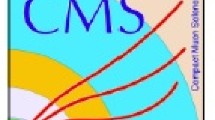Abstract
The observation of the strong suppression of high-p t hadrons in heavy-ion collisions at the Relativistic Heavy Ion Collider (RHIC) at BNL has motivated a large experimental program using hard probes to characterize the deconfined medium created. However, what can be denoted as “leading particle” physics accessible at RHIC presents some limitations which motivate at higher energy the study of much more penetrating objects: jets. The gain in center-of-mass energy expected at the Large Hadron Collider (LHC) at CERN will definitively improve our understanding on how the energy is lost in the system, opening a major new window of study: the physics of jets on an event-by-event basis. We will concentrate on the expected performance for jet reconstruction in ALICE using the EMCal calorimeter.
Similar content being viewed by others
References
X. N. Wang, M. Gyulassy, and M. Plumer, Phys. Rev. D 51, 3436 (1995).
A. Accardi et al., Writeup of the Working Group Jet Physics for the CERN Yellow, CERN-2004-009-B, hep-ph/0310274.
ALICE Collab., ALICE Physics Performance Report, Vol. II; J. Phys. G 32, 1295 (2006).
C. A. Salgado and U. A. Wiedemann, Phys. Rev. Lett. 93, 042301 (2004).
M. J. Tannenbaum, PoS CFRNC2006, 001 (2006).
A. Morsch, Nucl. Phys. A 783, 427 (2007).
T. M. Cormier, Eur. Phys. J C 34, S333 (2004).
ALICE Collab., Electromagnetic Calorimeter, Addendum to the Technical Proposal, CERN-LHCC-2006-014.
J. Adams et al. (STAR Collab.), Phys. Rev. Lett. 91, 172302 (2003).
S. S. Adler et al. (PHENIX Collab.), Phys. Rev. Lett. 91, 072301 (2003).
J. Adams et al. (for STAR Collab.), Phys. Rev. Lett. 90, 082302 (2003); M. Horner (STAR Collab.), J. Phys. G 34, S995 (2007).
C. Pruneau (for STAR Collab.), nucl-ex/0703010; F. Wang and J. Ulery (STAR Collab.), nucl-ex/0609017.
S. S. Adler et al. (PHENIX Collab.), hep-ex/0307019.
S. Y. Jeon, J. Jalilian-Marian, and I. Sarcevic, Phys. Lett. B 562, 45 (2003).
A. Dainese, C. Loizides, and G. Paic, Eur. Phys. J. C 38, 461 (2005).
B. I. Abelev et al. (STAR Collab.), Phys. Rev. Lett. 97, 252001 (2006).
D. Acosta et al. (CDF Collab.), Phys. Rev. D 68, 012003 (2003).
ALICE Collab., ALICE PPR, Vol. I, J. Phys. G 30, 1517 (2004).
G. Arnison et al. (UA1 Collab.), Phys. Lett. B 132, 214 (1983).
S. L. Blyth et al., nucl-ex/0609023.
Author information
Authors and Affiliations
Corresponding author
Additional information
(for the ALICE Collaboration)
The text was submitted by the author in English.




